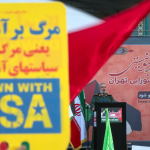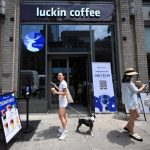The United States has prided itself on being the magnet for the world’s brightest talent.
The “American Dream” was a promise for everyone around the world.
And the H-1B visa has been the main gateway for scientists, engineers and entrepreneurs to make it to the land of freedom.
In recent days, the Trump administration has pushed through a steep new $100,000 fee on new H-1B petitions and mounted a high-profile raid on a Hyundai battery plant in Georgia, arresting hundreds of Korean workers.
Together, these actions indicate a broader crackdown that goes beyond routine immigration politics.
It is now ambiguous if the US is still open to skilled talent from Asia, or whether it is deliberately pricing it out.
The two key points
On 19 September, President Trump issued a proclamation imposing a $100,000 payment on any new H-1B petition filed after 21 September.
Initial reports described it as an annual levy.
Clarifications from federal agencies later confirmed that it is a one-time charge, not applicable to current visa holders.
But even so, the move represents a dramatic increase in the cost of hiring skilled foreign workers.
The timing is notable. Only months earlier, USCIS implemented “H-1B modernization” rules that expanded site-visit authority, restructured the lottery to reduce gaming and extended F-1 cap-gap protection.
The message was already one of tighter scrutiny. Now the new fee raises the bar from compliance to outright cost rationing.
In parallel, Homeland Security agents stormed Hyundai’s plant in Ellabell, Georgia, detaining 475 Korean nationals in one of the largest workplace raids in decades.
Officials said many were in violation of visa rules, but the optics were unmistakable.
A project central to America’s electric vehicle push was turned into a battlefield of immigration enforcement.
Why Indians and Koreans feel the shock differently
According to Pew Research, India accounts for nearly 70% of H-1B approvals. This percentage has skyrocketed since 2008, specifically.
In fiscal year 2024, USCIS granted nearly 400,000 H-1B petitions, with 141,000 for initial employment.
The $100,000 entry fee falls hardest on Indian IT services firms and technology start-ups that have long used the programme as an entry ramp for offshore engineers.
Larger companies can pay. Smaller ones will hesitate or abandon plans to bring talent in.
The knock-on effect is already visible. Indian IT stocks have fallen since the announcement, and the rupee has weakened as investors factor in reduced US onshoring.
Firms are shifting strategy towards L-1 intracompany transfers, building larger teams in Canada and Europe, and advising employees on F-1 to H-1B transitions without international travel.
Korea’s exposure is different. The country’s share of H-1B visas is small, but Korean groups are investing tens of billions in US chips and battery plants.
Their dependence is not on software engineers but on construction and commissioning staff. The Ellabell raid highlights the vulnerability of that model.
Multinationals can re-paper contracts and use L-1 visas for senior staff, but the perception of hostility will weigh on investment schedules.
Seoul has already linked visa frictions to the viability of its industrial expansion in America.
The economics of taxing talent
The new $100,000 requirement functions less as a safeguard than as a tariff on knowledge inflows.
The economics are straightforward. When you make entry more expensive, fewer workers arrive.
Research has repeatedly found that skilled immigrants lift local wages, increase patenting and expand the pool of human capital in US cities.
Peri, Shih and Sparber (2015) showed that increases in STEM H-1B workers correlated with wage gains for native-born college graduates.
Lincoln and Kerr (2008) found a direct link between H-1B admissions and higher patent output.
Restrictions do not typically boost native employment. Studies from Glennon (2023) and Mahajan et al. (2024) show that when companies lose access to H-1B workers, they do not replace them with Americans. They offshore the work.
That means less spending in the US, less clustering of talent, and a slower pace of innovation.
The new fee therefore advantages the largest tech firms that can swallow the cost, while squeezing universities, hospitals and start-ups.
The economic effect is regressive. Big incumbents survive, small innovators retreat, and second-tier tech hubs lose the most.
What lies beneath the policy change
If the economics are clear, the politics are clearer still. For years, conservatives argued they opposed only illegal immigration.
Skilled migration was supposed to be different.
But the lines are becoming blurred. The administration is indicating that now, even legal, high-skilled entry is suspect.
Much of this is about India. Indians dominate the H-1B pipeline, and they are increasingly visible in technology, academia and politics.
For sections of the American right, that visibility feeds a sense of demographic displacement at the top of the pyramid.
Social media battles over Indian engineers have become flashpoints in US culture wars.
Steve Bannon warned in 2016 that Asian CEOs were reshaping Silicon Valley. Amy Wax argued that Asian immigration tilted the electorate.
The new fee gives policy form to those anxieties.
For Koreans, the shock comes not from demographic politics but from spectacle enforcement.
The Ellabell raid was framed as a law-and-order exercise, but the symbolism is what matters.
A supply-chain partner considered central to US industrial policy was treated as expendable.
That undermines Washington’s credibility just as it asks allies to invest in US factories rather than Chinese ones.
What investors should watch
The headline numbers are clear. H-1B initial approvals will fall. L-1 and O-1 petitions will rise, but not enough to offset the loss.
Universities and research labs will feel the squeeze first.
The true test will be whether second-tier cities that had hoped to scale as tech hubs now stall.
Patent counts and VC deal flow will reveal that in the next two years.
For Indian IT firms, the adjustment will be to re-allocate work abroad and limit new US placements.
Investors should expect slower onshoring, higher compliance spend and more near-shore hiring in Canada and Europe.
For Korean conglomerates, the key variable is project execution.
Any delay in EV or chip plants because of visa frictions will hit construction contractors and local suppliers.
At a geopolitical level, the contradiction is glaring. The US says it wants to lead in semiconductors, EVs and advanced computing. That requires importing brainpower.
Instead, Washington is signalling hostility to the very engineers and commissioning staff who enable that build-out.
India and Korea are not just labour exporters. They are strategic allies. Alienating them weakens the coalition the US needs to balance China.
Perhaps the clearest signal is this: America is no longer just tightening compliance. It is deliberately raising the price of entry for skilled Asian workers.
Whether labelled protectionism, nationalism or cultural backlash, the effect is the same.
Fewer engineers in US labs, more code written offshore, and a credibility gap with allies.
The post Is Trump waging a war against skilled Asian immigrants? appeared first on Invezz







